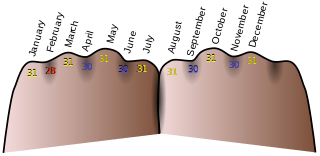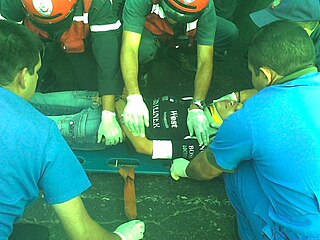Related Research Articles

A mnemonic device or memory device is any learning technique that aids information retention or retrieval (remembering) in the human memory for better understanding.
The Glasgow Coma Scale (GCS) is a clinical scale used to reliably measure a person's level of consciousness after a brain injury.
Forensic psychology is the practice of psychology applied to the law. Forensic psychology is the application of scientific knowledge and methods to help answer legal questions arising in criminal, civil, contractual, or other judicial proceedings. Forensic psychology includes research on various psychology-law topics, such as jury selection, reducing systemic racism in criminal law, eyewitness testimony, evaluating competency to stand trial, or assessing military veterans for service-connected disability compensation. The American Psychological Association's Specialty Guidelines for Forensic Psychologists reference several psychology subdisciplines, such as social, clinical, experimental, counseling, and neuropsychology.

Clinical neuropsychology is a sub-field of cognitive science and psychology concerned with the applied science of brain-behaviour relationships. Clinical neuropsychologists use this knowledge in the assessment, diagnosis, treatment, and or rehabilitation of patients across the lifespan with neurological, medical, neurodevelopmental and psychiatric conditions, as well as other cognitive and learning disorders. The branch of neuropsychology associated with children and young people is pediatric neuropsychology.

ROYGBIV is an acronym for the sequence of hues commonly described as making up a rainbow: red, orange, yellow, green, blue, indigo, and violet. There are several mnemonics that can be used for remembering this color sequence, such as the name "Roy G. Biv" or sentences such as "Richard of York Gave Battle in Vain".

Neuropsychological assessment was traditionally carried out to assess the extent of impairment to a particular skill and to attempt to determine the area of the brain which may have been damaged following brain injury or neurological illness. With the advent of neuroimaging techniques, location of space-occupying lesions can now be more accurately determined through this method, so the focus has now moved on to the assessment of cognition and behaviour, including examining the effects of any brain injury or neuropathological process that a person may have experienced.
SAMPLE history is a mnemonic acronym to remember key questions for a person's medical assessment. The SAMPLE history is sometimes used in conjunction with vital signs and OPQRST. The questions are most commonly used in the field of emergency medicine by first responders during the secondary assessment. It is used for alert people, but often much of this information can also be obtained from the family or friend of an unresponsive person. In the case of severe trauma, this portion of the assessment is less important. A derivative of SAMPLE history is AMPLE history which places a greater emphasis on a person's medical history.

The recurrent laryngeal nerve (RLN) is a branch of the vagus nerve that supplies all the intrinsic muscles of the larynx, with the exception of the cricothyroid muscles. There are two recurrent laryngeal nerves, right and left. The right and left nerves are not symmetrical, with the left nerve looping under the aortic arch, and the right nerve looping under the right subclavian artery then traveling upwards. They both travel alongside the trachea. Additionally, the nerves are among the few nerves that follow a recurrent course, moving in the opposite direction to the nerve they branch from, a fact from which they gain their name.
The SOAP note is a method of documentation employed by healthcare providers to write out notes in a patient's chart, along with other common formats, such as the admission note. Documenting patient encounters in the medical record is an integral part of practice workflow starting with appointment scheduling, patient check-in and exam, documentation of notes, check-out, rescheduling, and medical billing. Additionally, it serves as a general cognitive framework for physicians to follow as they assess their patients.

Advanced trauma life support (ATLS) is a training program for medical providers in the management of acute trauma cases, developed by the American College of Surgeons. Similar programs exist for immediate care providers such as paramedics. The program has been adopted worldwide in over 60 countries, sometimes under the name of Early Management of Severe Trauma, especially outside North America. Its goal is to teach a simplified and standardized approach to trauma patients. Originally designed for emergency situations where only one doctor and one nurse are present, ATLS is now widely accepted as the standard of care for initial assessment and treatment in trauma centers. The premise of the ATLS program is to treat the greatest threat to life first. It also advocates that the lack of a definitive diagnosis and a detailed history should not slow the application of indicated treatment for life-threatening injury, with the most time-critical interventions performed early.
The Judicial College, formerly the Judicial Studies Board (JSB), established in 1979, is the organisation responsible for training judges in county, the Crown, and higher courts in England and Wales and tribunal judges in England and Wales, Scotland and Northern Ireland. This includes the training of magistrates and the chairmen and members of tribunals. The current chairman is Lady Justice Anne Rafferty, DBE. The name changed from Judicial Studies Board to Judicial College on 1 April 2011.
Edith F. Kaplan was an American psychologist. She was a pioneer of neuropsychological tests and did most of her work at the Boston VA Hospital. Kaplan is known for her promotion of clinical neuropsychology as a specialty area in psychology. She examined brain-behavioral relationships in aphasia, apraxia, developmental issues in clinical neuropsychology, as well as normal and abnormal aging. Kaplan helped develop a new method of assessing brain function with neuropsychological assessment, called "The Boston Process Approach."
OPQRST is a mnemonic initialism used by medical professionals to accurately discern reasons for a patient's symptoms and history in the event of an acute illness. It is specifically adapted to elicit symptoms of a possible heart attack. Each letter stands for an important line of questioning for the patient assessment. This is usually taken along with vital signs and the SAMPLE history and would usually be recorded by the person delivering the aid, such as in the "Subjective" portion of a SOAP note, for later reference.
STRIDE is a model for identifying computer security threats developed by Praerit Garg and Loren Kohnfelder at Microsoft. It provides a mnemonic for security threats in six categories.

Acroosteolysis is resorption of the distal bony phalanges. Acroosteolysis has two patterns of resorption in adults: diffuse and bandlike.

The thermodynamic square is a mnemonic diagram attributed to Max Born and used to help determine thermodynamic relations. Born presented the thermodynamic square in a 1929 lecture. The symmetry of thermodynamics appears in a paper by F.O. Koenig. The corners represent common conjugate variables while the sides represent thermodynamic potentials. The placement and relation among the variables serves as a key to recall the relations they constitute.

A stab wound is a specific form of penetrating trauma to the skin that results from a knife or a similar pointed object. While stab wounds are typically known to be caused by knives, they can also occur from a variety of implements, including broken bottles and ice picks. Most stabbings occur because of intentional violence or through self-infliction. The treatment is dependent on many different variables such as the anatomical location and the severity of the injury. Even though stab wounds are inflicted at a much greater rate than gunshot wounds, they account for less than 10% of all penetrating trauma deaths.
Rapid trauma assessment is a method most commonly used by emergency medical services to identify hidden and obvious injuries in a trauma victim. The goal is to identify and treat immediate threats to life that may not have been obvious during an initial assessment. After an initial assessment involving basic checks on airway, breathing and circulation, the caregiver considers things like mechanism of injury to determine if a more rapid diagnostic approach is indicated than might otherwise be used. A rapid trauma assessment should take no more than 90 seconds.

Allochrocebus is a primate genus including the terrestrial guenons: the L'Hoest's monkey, the Preuss's monkey, and the sun-tailed monkey.
References
- ↑ Ed Dickinson; Dan Limmer; O'Keefe, Michael F.; Grant, Harvey D.; Bob Murray (2008). Emergency Care (11th ed.). Englewood Cliffs, N.J: Prentice Hall. pp. 251–3. ISBN 978-0-13-500524-8.
- 1 2 Taber, Clarence Wilbur; Venes, Donald (2009). Taber's cyclopedic medical dictionary. F A Davis Co. p. 579. ISBN 978-0-8036-1559-5.